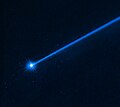Datei:Hubble sees boulders escaping from asteroid Dimorphos (heic2307a).jpg
aus Wikipedia, der freien Enzyklopädie
Zur Navigation springen
Zur Suche springen

Größe dieser Vorschau: 674 × 599 Pixel. Weitere Auflösungen: 270 × 240 Pixel | 540 × 480 Pixel | 864 × 768 Pixel | 1.152 × 1.024 Pixel | 1.505 × 1.338 Pixel
Originaldatei (1.505 × 1.338 Pixel, Dateigröße: 522 KB, MIME-Typ: image/jpeg)
![]()
Diese Datei und die Informationen unter dem roten Trennstrich werden aus dem zentralen Medienarchiv Wikimedia Commons eingebunden.
Beschreibung
| BeschreibungHubble sees boulders escaping from asteroid Dimorphos (heic2307a).jpg |
English: This NASA/ESA Hubble Space Telescope image of the asteroid Dimorphos was taken on 19 December 2022, nearly four months after the asteroid was impacted by NASA’s DART (Double Asteroid Redirection Test) mission. Hubble’s sensitivity reveals a few dozen boulders knocked off the asteroid by the force of the collision. These are among the faintest objects Hubble has ever photographed inside the Solar System. The ejected boulders range in size from 1 metre to 6.7 metres across, based on Hubble photometry. They are drifting away from the asteroid at around a kilometre per hour. The discovery yields invaluable insights into the behaviour of a small asteroid when it is hit by a projectile for the purpose of altering its trajectory.[Image Description: The bright white object at lower left is the asteroid Dimorphos. It has a blue dust tail extending diagonally to the upper right. A cluster of blue dots surrounds the asteroid. These are boulders that were knocked off the asteroid when, on 26 September 2022, NASA deliberately slammed the half-tonne DART impactor spacecraft into the asteroid as a test of what it would take to deflect some future asteroid from hitting Earth. Hubble photographed the slow-moving boulders in December 2022.] |
| Datum | 20. Juli 2023 (Hochladedatum) |
| Quelle | Hubble sees boulders escaping from asteroid Dimorphos |
| Urheber | NASA, ESA, D. Jewitt (UCLA) |
| Andere Versionen |
|
Lizenz
| ESA/Hubble images, videos and web texts are released by the ESA under the Creative Commons Attribution 4.0 International license and may on a non-exclusive basis be reproduced without fee provided they are clearly and visibly credited. Detailed conditions are below; see the ESA copyright statement for full information. For images created by NASA or on the hubblesite.org website, or for ESA/Hubble images on the esahubble.org site before 2009, use the {{PD-Hubble}} tag.
Conditions:
Notes:
|
Diese Datei ist lizenziert unter der Creative-Commons-Lizenz „Namensnennung 4.0 international“.
Namensnennung: ESA/Hubble
- Dieses Werk darf von dir
- verbreitet werden – vervielfältigt, verbreitet und öffentlich zugänglich gemacht werden
- neu zusammengestellt werden – abgewandelt und bearbeitet werden
- Zu den folgenden Bedingungen:
- Namensnennung – Du musst angemessene Urheber- und Rechteangaben machen, einen Link zur Lizenz beifügen und angeben, ob Änderungen vorgenommen wurden. Diese Angaben dürfen in jeder angemessenen Art und Weise gemacht werden, allerdings nicht so, dass der Eindruck entsteht, der Lizenzgeber unterstütze gerade dich oder deine Nutzung besonders.
Kurzbeschreibungen
Ergänze eine einzeilige Erklärung, was diese Datei darstellt.
This NASA/ESA Hubble Space Telescope image of the asteroid Dimorphos was taken on 19 December 2022, nearly four months after the asteroid was impacted by NASA’s DART (Double Asteroid Redirection Test) mission.
In dieser Datei abgebildete Objekte
Motiv
image/jpeg
1.338 Pixel
1.505 Pixel
534.475 Byte
2c6df9e0f2014ca75be69c167397efe10acb6c11
20. Juli 2023
pHash checksum Englisch
3oa07vw42yglymf21gmbyqz0h4ai1kd3zp5s8f26nqhnulah64
Dateiversionen
Klicke auf einen Zeitpunkt, um diese Version zu laden.
| Version vom | Vorschaubild | Maße | Benutzer | Kommentar | |
|---|---|---|---|---|---|
| aktuell | 10:00, 21. Jul. 2023 |  | 1.505 × 1.338 (522 KB) | OptimusPrimeBot | #Spacemedia - Upload of https://cdn.spacetelescope.org/archives/images/large/heic2307a.jpg via Commons:Spacemedia |
Dateiverwendung
Die folgende Seite verwendet diese Datei:
Globale Dateiverwendung
Die nachfolgenden anderen Wikis verwenden diese Datei:
Metadaten
Diese Datei enthält weitere Informationen (beispielsweise Exif-Metadaten), die in der Regel von der Digitalkamera oder dem verwendeten Scanner stammen. Durch nachträgliche Bearbeitung der Originaldatei können einige Details verändert worden sein.
| Fotograf | Space Telescope Science Institute Office of Public Outreach |
|---|---|
| Urheberrechte |
|
| Quelle | ESA/Hubble |
| Namensnennung/Veröffentlicher | NASA, ESA, D. Jewitt (UCLA) |
| Bildtitel |
|
| Kurztitel |
|
| Nutzungsbedingungen |
|
| Erfassungszeitpunkt | 16:00, 20. Jul. 2023 |
| JPEG-Dateikommentar | This Hubble Space Telescope image of the asteroid Dimorphos was taken on December 19, 2022, nearly four months after the asteroid was impacted by NASA’s DART mission (Double Asteroid Redirection Test). Hubble’s sensitivity reveals a few dozen boulders knocked off the asteroid by the force of the collision. These are among the faintest objects Hubble has ever photographed inside the solar system. The free-flung boulders range in size from three feet to 22 feet across, based on Hubble photometry. They are drifting away from the asteroid at a little more than a half-mile per hour. The discovery yields invaluable insights into the behavior of a small asteroid when it is hit by a projectile for the purpose of altering its trajectory. |
| Software | Adobe Photoshop 24.4 (Macintosh) |
| Speicherzeitpunkt | 12:49, 11. Jul. 2023 |
| Digitalisierungszeitpunkt | 10:10, 30. Aug. 2022 |
| Datum, zu dem die Metadaten letztmalig geändert wurden | 09:29, 11. Jul. 2023 |
| Eindeutige Kennung des ursprünglichen Dokuments | xmp.did:d9c7a64c-476d-4ed2-81e9-23aa0ed35ea1 |
| Urheberrechtsstatus | Urheberrechtsstatus nicht festgelegt |
| Stichwörter | Dimorphos |
| Kontaktinformationen | outreach@stsci.edu
ESA Office, Space Telescope Science Institute, 3700 San Martin Dr Baltimore, MD, 21218 United States |
| IIM-Version | 4 |


